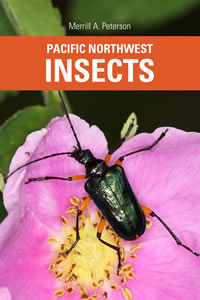The site includes guide to identifying insects,discussion forums, and a vast collection of images. “We are an online community of naturalists who enjoy learning about and sharing our observations of insects, spiders, and other related creatures.”
Keyword: Insects
Pacific Northwest Insects
 Fascinated by all the small life forms you find in your garden? Perhaps not, but it is still valuable for gardeners to know about them. “Pacific Northwest Insects” by Merrill Peterson will help. This excellent new field guide provides incredible color photos of over 1,200 species native to our region. The scope is the phylum Arthropoda, so this includes all the true insects (bees, beetles, butterflies, flies, etc.) plus centipedes, sow bugs, spider mites, and even spiders and ticks (yikes!).
Fascinated by all the small life forms you find in your garden? Perhaps not, but it is still valuable for gardeners to know about them. “Pacific Northwest Insects” by Merrill Peterson will help. This excellent new field guide provides incredible color photos of over 1,200 species native to our region. The scope is the phylum Arthropoda, so this includes all the true insects (bees, beetles, butterflies, flies, etc.) plus centipedes, sow bugs, spider mites, and even spiders and ticks (yikes!).
This wider scope means this book provides better coverage of the many “bugs” you’ll find in your garden. Peterson recognizes the importance of plants to the insect world and visa-versa. “Given the specialized associations between insects and plants, it is no wonder that many entomologists are skilled field botanists.” This book is the most comprehensive in the Miller Library collection for this region and our reference copy will help you with any identifying invertebrate visitors to your garden.
If you can get past the creepy factor, there’s also a lot of fascinating facts to discover. Did you know that moths are a significant food source for grizzly bears in the Rocky Mountains fattening up for their winter hibernation? Or that beetles are the most diverse and numerous order of multicellular animals in the world, making up 20% of all species? Many visitors think the Pacific Northwest has limited insect life. That’s not true – this book will help you identify over 3,000 species – but we lack many “huge or gaudily colored insects.”
Excerpted from the Spring 2019 Arboretum Bulletin.
Xerces Society for Invertebrate Conservation
The Xerces Society is a science-based conservation organization and international nonprofit. The society’s work focuses on protecting pollinators, conserving endangered species, and advocacy. The website contains an extensive publications library which includes technical reports for scientists, planting guides for homeowners and the biannual journal Wings. There are also resources specially designed for teachers and students.
Invasive and Exotic Species of North America – Images
A photo database of invasive plants, plant diseases and harmful insects, plus biological control agents providing “an accessible and easily used archive of high quality images…with an emphasis on educational applications.” Images are available to download for non-profit and educational purposes.
Garden Tip #106
To find pictures of insects go online to www.insectimages.org, Developed by Bugwood Network and the USDA Forest Service, this free database can be browsed by category of insect or keyword searched.
Once a mystery insect has been identified go to Plant Disease and Insect Identification Pests Leaflet Series from WSU for information on insects commonly found in western Washington or Insect and Pest Series Index from Ohio State University for general garden pest fact-sheets.
Bug Zoo
 Does someone you know want an earwiggery? How about a wormery or a dragonfly den? If you know a child who loves bugs, this illustrated handbook of bug habitats will teach him or her how to capture, observe, and learn from these tiny animals respectfully, with an understanding of their delicate biology.
Does someone you know want an earwiggery? How about a wormery or a dragonfly den? If you know a child who loves bugs, this illustrated handbook of bug habitats will teach him or her how to capture, observe, and learn from these tiny animals respectfully, with an understanding of their delicate biology.